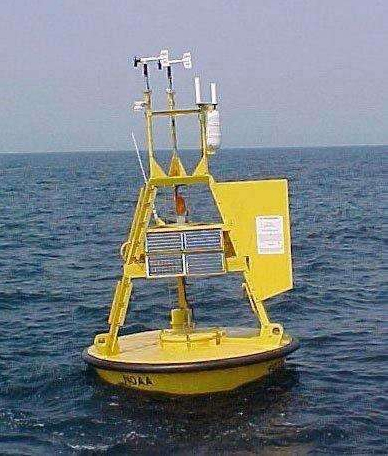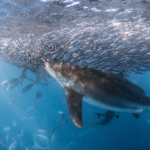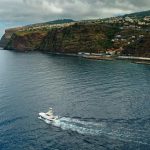February 21, 2014.
Mariners from surfers to businessmen say they’ve lost a vital source of information.
Buoy 41012, known locally as the St. Augustine buoy, was “disestablished” Wednesday, which is government speak for shut down. The U.S. Coast Guard picked it up and returned it to the National Data Buoy Center, which is part of the National Oceanic and Atmospheric Administration.
Mariners, commercial and recreational fishermen, surfers and maritime businesses relied on real-time data from the buoy located 40 miles offshore east-northeast of St. Augustine. The buoy’s data about ocean wind, sea temperature, wave action and other weather conditions was a touchstone as well for National Weather Service forecasters, marine search and rescue, and law enforcement agencies.
“If you’re a fisherman or a surfer or anyone who goes offshore, those buoys are really important because they will give you a really good idea of what’s happening offshore,” said Tom Schifanella of Atlantic Beach, a surfer and boater who often checks weather and wave data from the buoy several times a day.
“If you are a fisherman and you are going 20 miles offshore, you want to know if there is a 6- to 8-foot swell running because that is going to affect, from a safety point of view, if you are going to go out that far or what kind of conditions you might encounter,” Schifanella said.
Mitch Kaufmann, a surfing instructor, is among those who relied on the buoy.
“It’s my go-to buoy. …That buoy is the most accurate for letting us know how the waves are and what’s going on, of all the buoys around us,” said Kaufmann, vice president of the WaveMasters Society surfing club in Jacksonville Beach.
Kaufmann estimated that thousands of people, not just surfers, checked websites daily, sometimes several times, to get the most recent data about ocean and sea weather conditions that had been collected by the buoy.
The buoy was a casualty of last year’s federal budget restrictions, NOAA officials said.
It cost about $60,000 annually, plus Coast Guard support to service the buoy. No funding is available to keep the buoy operating. Efforts over the past few years to find an alternate funding source for it have failed, said Ben Sherman, communications director for NOAA’s National Ocean Service.
“The fact that this buoy is not being serviced is a tragedy. Or will be a tragedy waiting to happen,” Walker Palmer of Jacksonville said in an email to the NOAA’s Marine and Coastal Services branch of the National Weather Service.
U.S. Sen. Bill Nelson, D-Fla., has asked NOAA to try to find the money to restore the buoy, said Emily Rogers, his deputy press secretary.
A research buoy, it was never intended for other purposes. Research buoys typically last four or five years. Buoy 41012, deployed in June 2002, outlived its intended life expectancy, said Wayne Presnell, a meteorologist with NOAA’s Marine and Coastal Services branch.
“This buoy is critically needed for operational oceanography,” said Mitchell Roffer, an adjunct professor in the Department of Marine and Environmental Systems at the Florida Institute of Technology in Melbourne.
Because it was farther offshore than most buoys, the St. Augustine buoy provided better data, especially about offshore winds, used by weather forecasters looking for coastal storms and storm surge as well as for search and rescue, Roffer said.
Roffer said his Roffer’s Ocean Fishing Forecasting Service Inc., a scientific consulting company, will have to rely on another source for the data in products it sells to fishermen and for the information on currents it sometimes provides to the Coast Guard.
There are no immediate plans to replace the buoy. However, similar buoys offshore of Cape Canaveral and at Gray’s Reef near Savannah will fill in the gap left by the loss of the Buoy 41012, according to the Coast Guard. Sherman said NOAA has other data-collecting resources in place “that support safe navigation and weather forecasting.”
Schifanella, Roffer and other mariners remain concerned. On a typical day, conditions could be “very different” over roughly a 100-mile stretch of ocean between the remaining offshore buoys, Schifanella said.
“On a typical nor’easter, a lot of times those nor’easter fronts will stall just north of the Canaveral area and you might have 10-foot seas 20 miles offshore here and then down there, it could be completely different depending on which side of the front you are on.
“If I was a fisherman and I was depending on a buoy that far away, from a safety point of view, I would be very concerned about it. Because I really wouldn’t know what was going on out there.”
Describing himself as a recreational fisherman and concerned mariner, Mitch Gurick of St. Augustine expressed concern about the economic impact of the buoy’s loss in a letter to Nelson last March.
“The economic implications of NWS Forecast accuracy and the potential increased costs of government agencies involved in marine safety and enforcement operations is huge. … The annual operating cost of $60,000 for the buoy … is small relative to the potential economic impact of not having the data available,” Gurick wrote.

Re-posted from the Florida Times-Union – February 24, 2014
Teresa Stepzinski: (904) 359-4075





